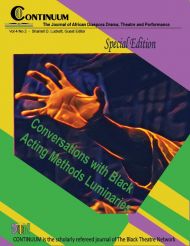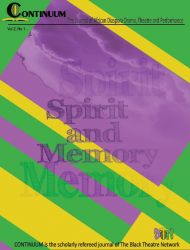Last Sunday:
Using Collaborative Playbuilding to Understand Why Some African Americans Leave the Black Church
James Webb
Abstract
Collaborative playbuilding is an emerging qualitative arts-based research design that is participatory in nature and draws upon the expertise of its research participants to assist with data collection, analysis, and the dissemination of research findings, which includes creating a performance script, rehearsing with actors, and dialoguing with audience members in a post-show talk-back session (Campana, 2005; Norris, 2009). This type of research repositions participants from a passive to a more active state of engagement by placing them at the helm of the research process. Participants are considered to be co-collaborators with the primary research investigator, and they play an active role in the scriptwriting, rehearsal, and public performance of generated data (Norris, 2009). I used collaborative playbuilding as a means to bring together in a dialogic process both current and former long-term members of the Black Church. I engaged the participants, using traditional qualitative methods (e.g. interviews, observations, and a focus group) to investigate their experiences within the Black Church, and I asked each participant to assist in crafting the performance script, rehearse with actors, and speak to audience members in a post-show talk-back session with the goal of discovering what motivates some long-term members of Black churches to leave and not return.
Collaborative playbuilding is an emerging qualitative arts-based research design that is participatory in nature and draws upon the expertise of its research participants to assist with data collection, analysis, and the dissemination of research findings, which includes creating a performance script, rehearsing with actors, and dialoguing with audience members in a post-show talk-back session (Campana 2005; Norris 2009). This type of research repositions participants from a passive to a more active state of engagement by placing them at the helm of the research process. The methods employed by collaborative playbuilding are similar to those of performance ethnography in that researchers use interviews, observations, and focus groups to generate data that will be used (mostly verbatim) in a performance script and presented before a live audience. However, collaborative playbuilding is unique in that its design is not simply to report the findings of its research but also to fully involve its participants in that process. Therefore, data generation does not end with the presentation of the play but rather continues with post-show discussions with audiences and participants, causing an overlapping effect in the process of how data is generated, analyzed, and disseminated. Ultimately, there is no definitive claim on the methodology of collaborative playbuilding. Researchers adapt the form to fit the needs of their particular research questions.
Read the rest of this article in PDF. View PDF ![]()



